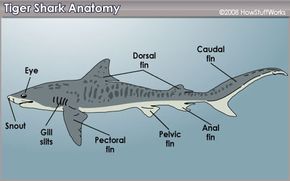Nicknames can either be awesome or embarrassing. In the best-case scenario, they reflect how cool someone thinks you are, and in the worse case, you're stuck being identified by a bad habit or a weird identifying feature.
Advertisement
The Galeocerdo cuvier, a shark identified by biologists in 1822, has a pretty cool nickname most of the time -- tiger shark. Tiger sharks got the moniker from the dark spots and stripes that cover the bodies of juveniles of this species, but the term also embodies all the ferocity that you would expect from a shark that ranks as the second deadliest shark after the great white [source: National Geographic].
To reinforce this point, tiger sharks are also part of a family Carcharhinidae, a family also known as requiem sharks. While "requin" is the French word for shark, the word likely derived from the requiems (or masses for the dead) that were held forwho came upon the more ferocious members of this family.
Despite all that violent glory, the tiger shark has become saddled with a more dubious nickname: "garbage can of the sea." It turns out the tiger shark will eat just about anything, from the sea turtles and seals that make up the main part of its diet, to more exotic items like rubber tires, beer bottles, nails, driver's licenses, explosives, clothes, a crocodile head, cats, pigs and a chicken coop with all its inhabitants [source: Martin]. In Australia, one tiger shark was found with an entire intact horse's head in its stomach [source: Tennesen].
So who are these deadly and hungry sharks? In this article, we'll take a closer look at Galeocerdo cuvier. A quick note before we begin that we'll be looking at the tiger shark, and not the similarly named sand tiger shark. But if you want maximum danger and an exotic diet, you've come to the right place. On the next page, we'll find out how to identify a tiger shark and learn about the anatomical features that differentiate them from other sharks.



